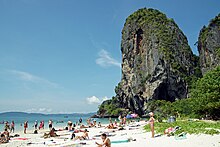From Wikipedia, the free encyclopedia
This article is about the town Krabi. For other uses, see Krabi (disambiguation).
| Krabi กระบี่ | |
|---|---|
| — Town — | |
| Country | |
| Province | Krabi Province |
| Population (2005) | |
| • Total | 24,986 |
Krabi (Thai: กระบี่) is a town (thesaban mueang) on the west coast of southern Thailand at the mouth of the Krabi River where it empties in Phangnga Bay. As of 2005 the town has a population of 24,986. The town is the capital of Krabi Province and Krabi district. Tourism is an important industry.
Contents[hide] |
[edit]Administration
The town covers the tambon Paknam and Krabi Yai of Krabi district, and is subdivided into 10 communities (chumchon).
[edit]Location
Krabi is a southern province on Thailand's Andaman seaboard with perhaps the country's oldest history of continued settlement. After dating stone tools, ancient colored pictures, beads, pottery and skeletal remains found in the province's many cliffs and caves, it is thought that Krabi has been home to Homo Sapiens since the period 25,000 - 35,000 B.C. In recorded times it was called the 'Ban Thai Samor', and was one of twelve towns that used, before people were widely literate, the monkey for their standard. At that time, c. 1200 A.D., Krabi was tributary to the Kingdom of Ligor, a city on the Kra Peninsula's east coast better known today as Nakhon Si Thammarat.
[edit]Climate
Facing the Andaman sea, like Phuket, Krabi is subject to a 6-month rainy season between May and November[1] often with sustained very heavy rains for days at a time during the monsoons. In March, 2011, a severe storm caused a massive mudslide in Krabi, killing 10 people.[2]
[edit]History
At the start of the Rattanakosin or Bangkok period in the late eighteenth century, when the capital was finally settled at Bangkok, an elephant kraal was established in Krabi by order of Chao Phraya Nakorn (Noi), the governor of Nakhon Si Thammarat, which was by then a part of the Thai Kingdom. He sent his vizier, the Phra Palad, to oversee this task, which was to ensure a regular supply of elephants for the larger town. So many followers emigrated in the steps of the Phra Palad that soon Krabi had a large community in three different boroughs: Pakasai, Khlong Pon, and Pak Lao. In 1872, King Chulalongkorn graciously elevated these to town status, called Krabi, a word that preserves in its meaning the monkey symbolism of the old standard. The town's first governor was Luang Thep Sena, though it continued a while as a dependency of Nakhon Si Thammarat. This was changed in 1875, when Krabi was raised to a fourth-level town in the old system of Thai government. Administrators then reported directly to the central government in Bangkok, and Krabi's history as a unique entity separated from the other provinces, had begun.
[edit]Tourism
Much of the province has been the seat of several national parks. The topmost destinations are Hat Noppharat Thara, Ao Nang, Railay, Ko Phi Phi National Park. Yet over 80 smaller islands such as Lanta islands, or Koh Lanta, Phi Phi islands - made famous as the ideal location for adventurers, yachtsmen, scuba-divers, snorkelers and day-trippers from Phuket.
Krabi is growing fast, in the last few years Tesco, HomePro, Big C have all opened and a new International hospital is in the final stages of construction. Krabi has a reputation of being a true Thai countryside location and with the now enlarged Krabi International airport is seen as the ideal balance between convenience and lifestyle. People are being drawn to Krabi in search of the idyllic beach life that Phuket and Koh Samui offered a decade ago but are in danger of losing as they get bigger. International residents are catered for, although on a smaller scale than Phuket, with regard to immigration services and English speaking staff in local government offices. Entertainment options are on the increase as are true International standard Hotels and attractions. To cater for the inward surge of potential residents, many real estate companies have emerged building high quality villas and homes specifically for foreigners.
The Ko Lanta National Park, also in Krabi province, includes several coral-fringed islands with well-known diving sites. The largest island, Ko Lanta Yai, is the site of park headquarters, and is also home to Chao Le, or sea gypsies who sustain themselves largely through fishing. The islands are best visited during the non-monsoon months of October through April.
Kayaking, sailing, birdwatching, snorkeling are also among top activities. In the interior, two predominantly mainland national parks, Khao Phanom Bencha and Than Bokk-horani, offer inland scenic attractions including waterfalls and caves, and opportunities for trekking, birdwatching and eco-tours.
The rock faces at Railay Beach near Aonang have attracted climbers from all over the world and each year are the venue for the Rock and Fire Festival. There are several Rock Climbing schools at Railay beach.
[edit]Transport
Since 1999 the town has been served by the international Krabi Airport. Passing through the town is Phetkasem Road (Thailand Route 4).






No comments:
Post a Comment